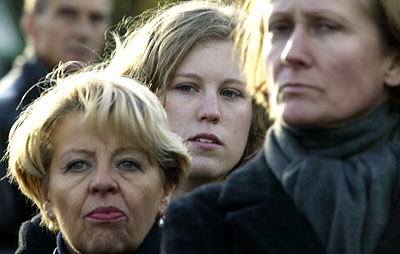Uncovering Berlin

Framed by Beliners, Caliandra Lanza-Weil ’06 is attentive during a tour of historic Nazi sites during her Bates Fall Semester program in Berlin.
Every week during their fall semester in Berlin, history professors Steve Hochstadt and Elizabeth Tobin joined their students in an exploration of the city and its surroundings, on guided tours of neighborhoods and museums, and to a concentration camp and a castle.
Each student was asked them to pick out a place of their own, about which they could read and talk to people. “We asked them to go there, look, and observe — see what role that place plays in Berlin’s life.” Below are the results of those investigations: 10 student essays, each one describing one of those Berlin places, coupled with photography by Bates Magazine staff photographer Phyllis Graber Jensen.
- Lindley Brainard ’06 at Onklel Philipp’s Spielzeug Werkstatt
- Kathryn Clark ’06 at Mauerpark
- Stephanie Garcia ’06 at Sachsenhausen
- Andrew Jarboe ’05 at Sowjetisches Ehrenmal
- Caliandra Lanza-Weil ’06 at Judisches Museum Berlin
- John Mulligan ’06 at Berlin Abgeordnetenhaus
- Tanya Nauvel ’06 at Hochschule fur Musik Hanns Eisler
- Fabio Periera ’07 at Kadewe
- Melissa Simones ’06 at Friedrichshain Volkspark
- Michael Wilson ’07 at Torpedokafer
In walking the streets of Berlin, they learned the modern history of German history, “where a residue of buildings, monuments, and architectural styles connect us to the past. to see those residues,” said the professors.
“Every aspect of our program came together in these projects: trying to understand German history and culture; getting comfortable in the city of Berlin; speaking in German; gaining independence and self-confidence; and learning from each otherm,” said Hochstadt and Tobin. “The lesson they learned, we hope, is how to examine their environment, getting past facades to learn the foundation of history and culture — a skill they can use wherever they go in life.”
Tobin and Hochstadt joined colleague Denis Sweet, professor of German, in teaching the Bates Fall Semester in Berlin 2004. Their students studied language at IES Berlin, whose staff organized home stays and programs for the Bates group. Sweet’s course, “How to Live a Life: A Primer of Modern German Thought,” complemented Tobin and Hochstadt’s course on the history of the city.